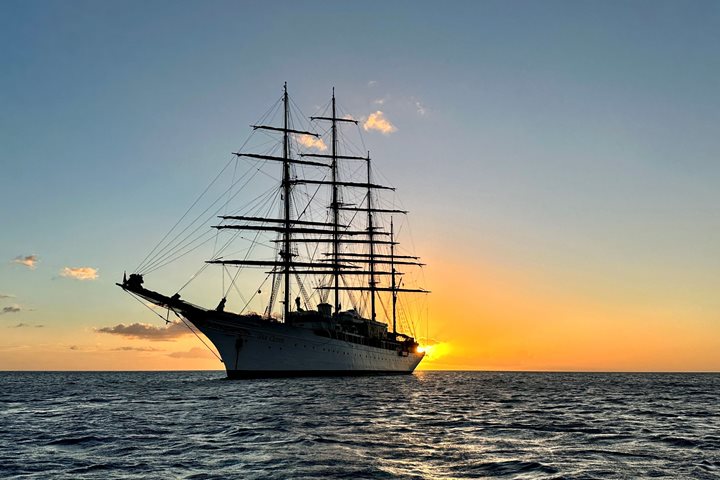“Let me stop here. Let me, too, look at nature awhile.
The brilliant blue of the morning sea, of the cloudless sky,
the yellow shore; all lovely,
all bathed in light”
The first verse of Constantine Cavafy’s Morning Sea seemed so appropriate for our morning at sea. Sea Cloud weighed anchor from our sheltered anchorage in the lee of Ios and headed back out in the blue, blue Aegean for a super sail in the 30-knot northerly winds. Braced square, the Captain set the fore main sail and upper and lower topsails plus the upper and lower topsails on the main and mizzen masts to allow us to smoothly slice through the whitecaps moving along at 5.2 knots.
We approached the caldera of Santorini from the south just after lunch, passing between the white tufa cliffs of the main island and Aspro Nisi off our port bow. The blazing sun and crystal blue skies seemed to accentuate the white tips of the storm tossed seas that persisted right into the basin of the caldera—so much for finding a “quiet port in a storm”! Transferring from the ship onto a Greek tender boat always adds a level of drama during the day. Despite the gusty conditions, the Captain did manage to find us a spot and create a “lee” so that we could all transfer into an official Greek tender for the short shuttle to Athinios.
As there were four huge cruise ships scheduled for Santorini today, and more tomorrow, we opted to just go ashore in the later afternoon to visit the archaeological site of Akrotiri. Buried in a thick layer of ash following the massive explosive eruption of 1627 B.C., Akrotiri may hold the key to the mystery of “The Lost Continent of Atlantis.” En route we stopped alongside the road to examine the unique method the island farmers have devised for growing grapes on this wind-swept island. The vines grow on the ground in a basket formed by the vine themselves. The farmers ensure the grapes are sheltered in the basket, which also helps to concentrate the morning dew on to the fruit.
Buried in volcanic ash 1500 years before Pompeii, the Minoan site of Akrotiri is eerily fascinating. The muted gray and earth tones of the ancient stones, the now silent streets that run the length of the site, empty bed and table frames all help to draw you into the drama of the situation when the Minoans realized that they had to flee their homes or perish. We might never know their individual fates but they left behind frescoed houses and shops filled with wares stored in large pithoi hoping to be able to return and restart their lives.
Back aboard Sea Cloud, we enjoyed a buffet dinner compete with Greek mezes, fresh grilled tuna, and a suckling pig while we cruised back and forth below the sun-kissed cliffs of this magical isle.







